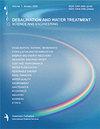Removal of Cr(III) from aqueous solutions using waste kelp-derived biochar
IF 1
4区 工程技术
Q4 ENGINEERING, CHEMICAL
引用次数: 3
Abstract
This study aimed to investigate the feasibility of using biochar derived from waste kelp biochar (KB) to remove Cr(III) from aqueous solutions. Scanning electron microscopy-energy-dispersive X-ray spectroscopy analysis revealed that KB could successfully adsorb Cr(III), while Fourier transforms infrared spectroscopy characterization suggested that electrostatic interaction was the major mechanism for the adsorption of Cr(III) on KB. Kinetic and isotherm studies on Cr(III) adsorption revealed that the pseudosecond-order kinetic model and the Langmuir model could adequately explain the adsorption of Cr(III) on KB. The maximum adsorption capacity of KB for Cr(III) was found to be 39.16 mg/g, while 91.13% of Cr(III) removal could be achieved by adding KB to aqueous solutions with an initial Cr(III) concentration of 25 mg/L at 0.9 g/L. Our experiments on cation competition demonstrated that the presence of Ca2+ could markedly inhibit the adsorption of Cr(III) by KB, although the inhibition was not observed with the presence of K+, Na+, and Mg2+ in the solution. When monovalent anions such as C5H7O5COO and CH3COO were present in the solution, they reacted with Cr(III) to form stable complexes, thereby reducing the removal efficiency of Cr(III). On the other hand, the . of PO4 and SO4 did not cause any inhibition in the adsorption of Cr(III).利用废弃海带衍生生物炭从水溶液中去除铬(III)
本研究旨在探讨利用废海带生物炭(KB)衍生的生物炭去除水溶液中Cr(III)的可行性。扫描电镜-能量色散x射线能谱分析表明,KB能够成功吸附Cr(III),傅里叶变换红外光谱表征表明,静电相互作用是KB吸附Cr(III)的主要机制。对Cr(III)吸附的动力学和等温线研究表明,拟二级动力学模型和Langmuir模型能较好地解释Cr(III)在KB上的吸附。KB对Cr(III)的最大吸附量为39.16 mg/g,在初始Cr(III)浓度为25 mg/L、浓度为0.9 g/L的水溶液中加入KB, Cr(III)的去除率可达91.13%。我们的阳离子竞争实验表明,Ca2+的存在可以显著抑制KB对Cr(III)的吸附,尽管在溶液中存在K+, Na+和Mg2+时没有观察到这种抑制作用。当溶液中存在C5H7O5COO和CH3COO等单价阴离子时,它们与Cr(III)反应形成稳定的配合物,从而降低了Cr(III)的去除效率。另一方面,……PO4和SO4对Cr(III)的吸附没有任何抑制作用。
本文章由计算机程序翻译,如有差异,请以英文原文为准。
求助全文
约1分钟内获得全文
求助全文
来源期刊

Desalination and Water Treatment
工程技术-工程:化工
CiteScore
2.20
自引率
9.10%
发文量
0
审稿时长
5.3 months
期刊介绍:
The journal is dedicated to research and application of desalination technology, environment and energy considerations, integrated water management, water reuse, wastewater and related topics.
 求助内容:
求助内容: 应助结果提醒方式:
应助结果提醒方式:


